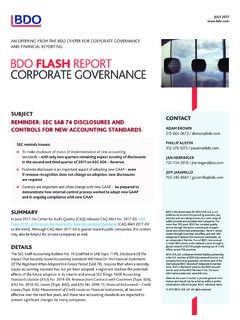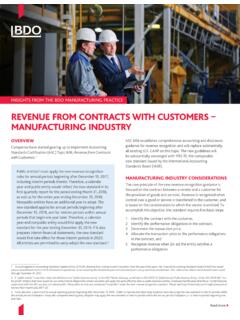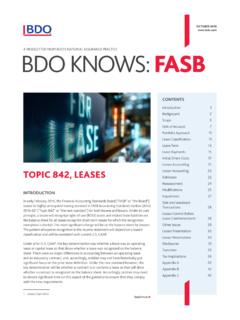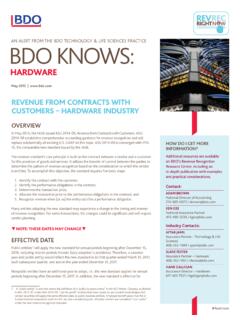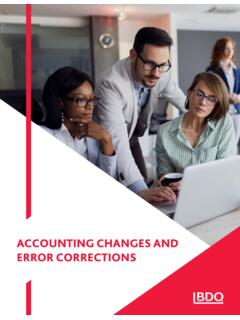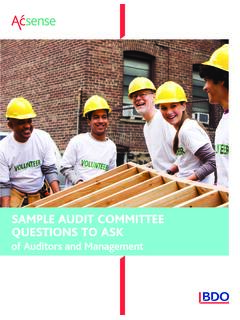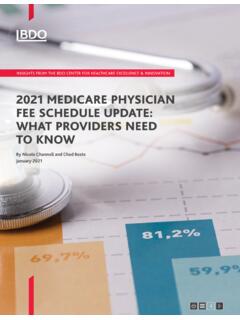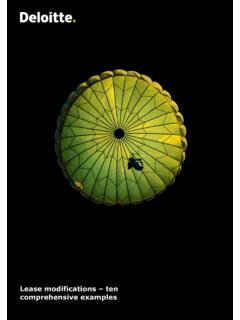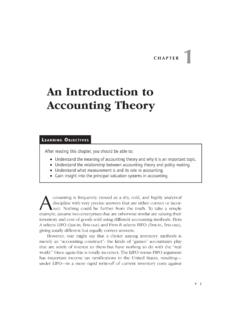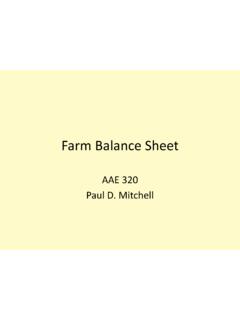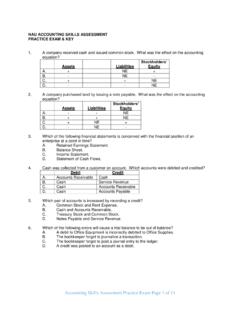Transcription of Accounting for Leases Under ASC 842 - BDO
1 Accounting FOR Leases Under ASC 842 1 A PRACTICE AID FROM BDO S PROFESSIONAL PRACTICE GROUP Accounting for Leases Under ASC 842 UPDATED DECEMBER 2021 Accounting FOR Leases Under ASC 842 2 Table of Contents INTRODUCTION .. 5 ASC 842 in a Nutshell .. 6 lease Classification .. 7 Lessee Accounting .. 8 Lessor Accounting .. 9 Adoption Dates .. 10 About the Practice Aid .. 10 CHAPTER 1 - SCOPE OF ASC 842 .. 12 Scope and Scope Exceptions .. 12 Specific Considerations for Land Easements .. 14 Interaction with Other Standards .. 17 CHAPTER 2 - IDENTIFYING A lease .. 18 Overview .. 18 Identified Asset .. 20 Right to Control Use of Identified Asset .. 27 Other Illustrations .. 42 CHAPTER 3 - IDENTIFYING AND SEPARATING COMPONENTS .. 48 Overview .. 48 Identifying lease and Nonlease Components .. 52 Separating Components - Lessees .. 60 Separating Components - Lessors .. 69 Portfolio Approach .. 80 Contract Combination.
2 80 CHAPTER 4 - lease CLASSIFICATION AND KEY TERMS .. 81 Overview .. 81 Commencement Date .. 84 lease Term .. 89 lease Payments .. 95 Initial Direct Costs .. 101 Discount Rate .. 102 Economic Life .. 106 Fair Value .. 106 lease Classification .. 107 Accounting FOR Leases Under ASC 842 3 CHAPTER 5 - Accounting FOR Leases LESSEES .. 111 Overview .. 111 lease Classification by Lessees .. 112 Summary Accounting Requirements Based on lease Classification .. 113 Short-Term Leases .. 114 Recognition and Initial Measurement .. 119 Subsequent Measurement .. 123 Remeasurements .. 130 Variable lease Payments that Depend on an Index or a Rate .. 137 Modifications .. 139 Impairment .. 152 Derecognition .. 158 CHAPTER 6 - Accounting FOR Leases LESSORS .. 159 Overview .. 159 lease Classification by Lessors .. 160 Summary Accounting Requirements Based on lease Classification .. 161 Sales-Type Leases A Deeper Dive.
3 163 Direct Financing Leases A Deeper Dive .. 176 Operating Leases .. 183 Modifications .. 185 Impairment .. 191 Other Transactions .. 195 CHAPTER 7 - OTHER TOPICS .. 196 Overview .. 196 Sale and Leaseback Transactions .. 197 Business Combinations (or Acquisitions by Not-For-Profit Entities) .. 227 Subleases .. 233 Accounting for Income Taxes .. 238 CHAPTER 8 - PRESENTATION AND DISCLOSURES .. 242 Overview .. 242 Presentation .. 243 Disclosure Requirements .. 248 CHAPTER 9 - ADOPTING ASC 842 .. 256 Overview .. 256 Effective Dates .. 258 Transition Methods .. 260 Transition Disclosures .. 263 Transition Practical Expedients .. 264 Transition Lessees .. 271 Transition - Lessors .. 282 Other Transition Requirements .. 286 Application of the Portfolio Approach in Transition .. 289 CONTACTS .. 290 Accounting FOR Leases Under ASC 842 4 THIS PRACTICE AID The Practice Aid includes detailed guidance and flowcharts on analyzing and Accounting for contracts Under Financial Accounting Standards Board (FASB) Accounting Standards Codification (ASC) 842, Leases .
4 The graphics and illustrations in this Practice Aid are provided to assist readers in understanding various aspects of the lease Accounting guidance. Accounting for contracts may vary based on the specific facts and circumstances of each contract and therefore may differ from the illustrations provided in the Practice Aid. The Practice Aid focuses on the Accounting for lease contracts Under ASC 842 only. Additional information on the Accounting for Leases Under International Financial Reporting Standards (IFRS) is available here. Accounting FOR Leases Under ASC 842 5 Introduction In February 2016, the Financial Accounting Standards Board ( FASB ) issued new lease Accounting guidance in ASU 2016-02, Leases ( ASC 842 ). Under its core principle, a lessee recognizes a right-of-use ( ROU ) asset and a related lease liability on the balance sheet for most Leases . The most significant change is on the balance sheet for lessees.
5 For the income statement, the pattern of expense recognition depends on a lease s classification but is generally consistent with current GAAP (ASC 840, Leases , or ASC 840 ). The objective for updating lease Accounting was to increase transparency and comparability among entities by recognizing lease assets and lease liabilities on the balance sheet by lessees for most Leases and by disclosing key information about leasing arrangements. This new guidance addressed stakeholder concerns that the previous lease Accounting guidance did not result in a faithful representation of leasing transactions; specifically, that the rights and obligations associated with operating Leases were not recognized on the balance sheet. Under ASC 840, lessees recognized capital Leases on the balance sheet but only disclosed operating Leases as off-balance sheet arrangements. There were no major differences in the Accounting treatment for an operating lease versus a service contract.
6 ASC 842 now changes that and, as such, the key determination will be whether a contract is or contains a lease as that will drive whether a contract is recognized on the balance sheet. The Leases project began as one of several joint projects between the FASB and the International Accounting Standards Board (IASB) aimed at converging GAAP and International Financial Reporting Standards (IFRS). However, after several years of deliberations and two exposure drafts, the FASB and IASB reached different conclusions on various aspects of lease Accounting (such as classification of Leases by lessees), and each of FASB and IASB issued separate guidance early in 2016. Additional information on the Accounting for Leases Under IFRS is available here. Accounting FOR Leases Under ASC 842 6 ASC 842 IN A NUTSHELL The following flowchart summarizes at a high level what an entity considers when applying ASC 842, which we will explore in further details throughout the Practice Aid.
7 * Exceptions exist when a lessee or lessor elect a practical expedient not to separate nonlease component(s) from the associated lease component (see Identifying and Separating Components). Accounting FOR Leases Under ASC 842 7 lease CLASSIFICATION The following flowchart summarizes classification of a lease by lessees and lessors Under ASC 842 (after adoption of ASU 2021-05): Accounting FOR Leases Under ASC 842 8 LESSEE Accounting As illustrated on the previous page, a lessee classifies a lease as either an operating lease or a finance lease using classification criteria that are generally consistent with ASC 840. The lease (whether operating or finance) is recognized on balance sheet at the commencement date unless the practical expedient for short-term Leases is elected (see below). The following table summarizes a lessee s Accounting for Leases : Finance Leases Operating Leases ROU Asset lease Liability ROU Asset lease Liability Balance Sheet ROU asset is initially measured at the amount of the lease liability, plus initial direct costs and prepaid lease payments, less lease incentives received.
8 lease liability is initially measured at the present value of the unpaid lease payments. Initial measurement is the same as for finance Leases . Subsequently, ROU asset is typically amortized on a straight-line basis to the earlier of the end of its useful life or lease Subsequently, lease liability is increased to reflect interest using the effective interest method and decreased for lease payments made. Amortize based on difference between periodic straight-line lease cost (incl. amortization of initial direct costs) and periodic interest accretion. Subsequent measurement is the same as for finance Leases . Income Statement Recognize amortization on ROU asset, interest on lease liability, and recognize variable lease payments not included in the lease liability when Recognize single lease cost ( , lease payments plus initial direct costs) generally on a straight-line basis, and variable lease payments not included in lease liability when Cash Flow Statement Classify repayments of principal portion of lease liability within financing activities and payments of interest on the lease liability and variable lease payments within operating activities.
9 Classify all cash payments for Leases within operating activities. Once recognized on balance sheet, ASC 842 includes requirements for lessees to update the measurement of Leases for certain lease modifications and other reassessment events. Lessees will need robust processes and controls to timely and completely identify and account for such events. When the lease liability is remeasured and the ROU asset adjusted, amortization of the ROU asset is adjusted prospectively from the date of remeasurement. The FASB also provided lessees with a practical expedient not to recognize short term Leases on balance sheet. A short-term lease is a lease with a lease term of 12 months or less and that does not include a lessee option to purchase the underlying asset that is reasonably certain of exercise. This election is by asset class and, if elected, a lessee recognizes lease payments on a straight-line basis over the lease term along with variable lease payments when incurred, consistent with ASC 840.
10 1 If the lease transfers ownership of the underlying asset to the lessee or the lessee is reasonably certain to exercise an option to purchase the underlying asset, the lessee amortizes the right-of-use asset to the end of the useful life of the underlying asset. 2 If the ROU asset is impaired Under ASC 360, an impairment loss is also recognized. For operating Leases only, recognition in the income statement post-impairment no longer is on a straight-line basis (but still recognized as a single lease cost). Accounting FOR Leases Under ASC 842 9 LESSOR Accounting Lessor Accounting remains largely consistent with ASC 840, and a lessor will continue to classify Leases as either sales-type, direct financing or operating Leases . But lessor Accounting has also been updated for consistency with the new lessee Accounting model and with the new revenue standard in ASC 606, Revenue from Contracts with Customers ( ASC 606 ).
